In the bustling environment of an animal shelter, it is crucial to prioritize the emotional well-being of the animals in our care as well as the physical. At AWLA, our Behavior and Training team, led by Director Samantha Wolfman, has implemented Fear Free practices and philosophies in every aspect of shelter life. By adopting a fear-free approach, we reduce stress, promote trust, and set our animals up for success in their new homes. Shelters are already inherently stressful for animals, and our goal is to alleviate, rather than add to, their stress levels. By reducing fear and anxiety, we enable animals to showcase their true behavior, making it easier to find them new homes.
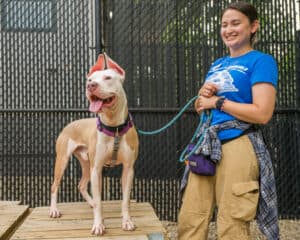
Sam Wolfman, Director of Foster & Pathway Planning, with Wilbur, a deaf dog who received extra training to begin learning sign language.
The Fear Free Shelter Program, founded in 2016 by Dr Marty Becker, aims to “improve the experiences of animals by educating shelter, rescue, and animal welfare employees and volunteers about their emotional needs. The Fear Free Shelter Program provides training suitable for all of the individuals involved in the care and oversight of shelter and rescue animals—from medical and behavioral staff to intake, reception, kennel, and cattery staff to animal control officers, adoption counselors, foster caregivers, and shelter volunteers.”
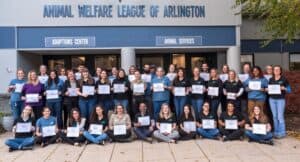
AWLA staff with their Fear Free certificates.
The way we implement the Fear Free program in our shelter is not limited to physical or active interventions; it extends beyond that to encompass creating an environment that ensures comfort and minimizes stress for our animals. This approach acknowledges that each animal is unique and may require different strategies to alleviate their fears. To ensure consistent implementation, all staff members are Fear Free-certified, and we encourage our volunteers to embrace these principles as well.
- Choice-Based Interactions: Our Animal Care Technicians (ACTs) prioritize choice-based interactions, never forcing an animal to engage in activities that make them uncomfortable. Physical force or manipulation is strictly avoided, and even scruffing is used only when absolutely necessary. During vaccinations, minimal restraint is employed, while food is utilized as a distraction and to create positive associations with veterinary environments.
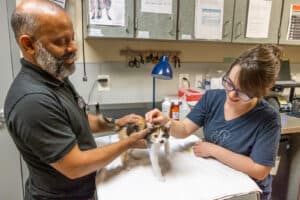
Animal Care staff use minimally invasive handling methods to vaccinate a kitten.
- Environmental Enrichment: Creating a calming environment is important for all our animals, but is especially critical for cats. We employ strategies such as using calming pheromones like Feliway and providing enriching elements like snuffle mats and slow feeders. Offering opportunities for animals to express natural behaviors – like sniffing or foraging – is one of the most enriching experiences we can provide them.
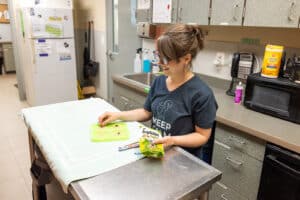
Animal Care Tech Mary prepares a food enrichment puzzle for a cat.
- Reward-Based Training: Our training methods are rooted in positive reinforcement, offering animals choices and opportunities to learn new behaviors with positive outcomes. Rather than punishing natural behaviors, which can be viewed as problematic, we teach them that there are alternative choices they can make, which thereby, empowers animals by giving them control over their situation. This, in turn, fosters a sense of confidence and security.
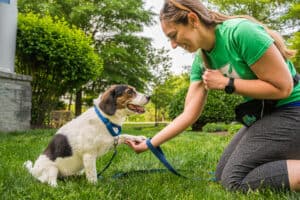
Volunteer Stacey uses reward-based training methods to work on Odin’s “shake” cue.
- Tailored Protocols: We assign specific protocols to animals to help individuals learn how to manage particular behaviors in a Fear Free manner. These protocols revolve around providing food, choice, and space, which not only reduces stress but also aids in their emotional well-being.
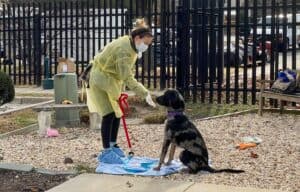
Samantha, Director of Foster & Pathway Planning, ensures that all animals receive a tailored approach to their care, even those in medical quarantine.
Fear Free practices can be the determining factor between adoption and months in a kennel for shelter animals. In many instances, animals may growl or exhibit discomfort during kennel or veterinary exams, which could be misunderstood and lead to euthanasia. By employing Fear Free practices, we prioritize understanding animal body language and communication, allowing us to make decisions based on the animal’s true emotions rather than a single circumstance. This approach has resulted in saving numerous dogs and cats who may have been deemed dangerous elsewhere based simply on a single snapshot of behavior.
Effective communication is also at the heart of Fear Free practices. By deciphering animals’ body language, vocalizations, and subtle cues, we can build a strong foundation of trust and establish a positive relationship. Understanding animal communication is vital in our work: it allows us to recognize and address their fears, meet their needs, and advocate for them. A dog in our care may exhibit reactive behaviors towards other dogs because they are afraid, but by recognizing their fear and/or frustration, we can adjust their routine and provide a supportive environment that minimizes stress and potential triggers. In veterinary exams, communication helps us ensure that our animals feel as calm and comfortable as possible. Ultimately, effective communication with animals is a gateway to building a strong human-animal bond. When we comprehend their needs, emotions, and desires, we can respond in ways that promote trust, respect, and mutual understanding. This bond is essential for their overall well-being, as it enables us to provide the care and support they need to thrive.

This cat is clearly communicating stress and fear through his ears, eyes, and body posture

Whereas this cat is communicating interest and curiosity.
Fear Free practices have become the guiding philosophy at AWLA, transforming the lives of the animals in our care. By prioritizing their emotional well-being, we create an environment of trust, understanding, and compassion. Through choice-based interactions, environmental enrichment, reward-based training, and tailored protocols, we empower animals to express their natural behaviors and build confidence. This approach not only enhances their chances of finding loving homes but also saves lives by dispelling misconceptions and allowing us to truly understand each animal’s needs. As we continue to champion Fear Free practices, we are committed to providing optimal welfare for all animals and strengthening the human-animal bond. Together, we can create a future where every shelter animal receives the care, understanding, and love they deserve.


